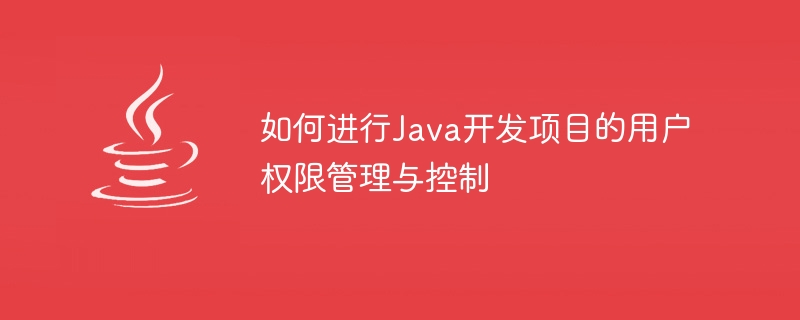How to manage and control user rights in Java development projects
- 王林Original
- 2023-11-02 14:31:101163browse

How to manage and control user rights in Java development projects
With the development of the Internet, Java development projects have become the first choice for many enterprises and individual developers. In Java development projects, user rights management and control are a very important and essential part. User rights management and control can ensure the security and stability of the project and prevent unauthorized users from tampering with or obtaining sensitive information in the system. This article will introduce some common methods and techniques on how to manage and control user rights in Java development projects.
1. Understand the concept of user rights management and control
User rights management and control refers to the process of authenticating and authorizing users in the system. User rights management refers to the process by which the system verifies and confirms the user's identity when the user registers or logs in to the system. User authorization means that after the user passes identity authentication, the system determines the operations that the user can perform in the system based on the user's role and permissions. The purpose of user rights management and control is to ensure that only users with corresponding rights can access resources in the system.
2. Use permission management framework
In Java development projects, you can use some mature permission management frameworks to implement user permission management and control. These frameworks can simplify our development work and improve development efficiency. Common Java permission management frameworks include Spring Security, Apache Shiro, etc. These frameworks provide a complete set of user authentication and authorization solutions that can help us quickly implement user rights management and control functions.
3. Define user roles and permissions
When managing and controlling user permissions, we must first clarify the user roles and permissions in the system. User roles are a way of classifying users in the system. Different roles have different permissions. User permissions refer to the specific operations that users can perform in the system. User permissions can be divided into read permissions, write permissions, delete permissions, etc. In Java development projects, user roles and permissions can be defined through database tables or configuration files.
4. Perform user authentication
User authentication is the first and most important step in user rights management and control. Common authentication methods include username and password-based authentication, token-based authentication, etc. In Java development projects, we can use a database to store user accounts and passwords, and use usernames and passwords for authentication. During the verification process, the user's password needs to be encrypted to increase system security.
5. User authorization
User authorization means that after the user passes identity verification, the system determines the specific operations that the user can perform based on the user's role and permissions. In Java development projects, user authorization can be performed using annotations or configuration files. The annotation method can limit user permissions by adding annotations in the code, while the configuration file method can load the user's role and permission information when the project is started, and set user access restrictions based on different roles and permissions.
6. Record user operation logs
In order to further improve the security of the system, you can record user operation logs in Java development projects. The user operation log can record the user's login information, operation time, operation type, etc. When an exception or unauthorized operation occurs in the system, you can find out the cause of the exception and the person responsible by viewing the user operation log.
Summary:
User rights management and control is a very important and essential link in Java development projects. By using a mature permission management framework, reasonably defining user roles and permissions, performing user authentication and authorization, and recording user operation logs, we can ensure the security and stability of the system. In the actual development process, it is necessary to select a suitable rights management solution based on the specific needs and scale of the project, and continuously optimize and improve it to provide better user experience and security.
The above is the detailed content of How to manage and control user rights in Java development projects. For more information, please follow other related articles on the PHP Chinese website!
Related articles
See more- mysql 用户权限管理 例子
- MySQL creates user rights table to implement user rights management function
- How to use PHP to develop user rights management functions
- How to conduct interface testing and integration testing of Java development projects
- How to optimize the code quality and performance of Java development projects